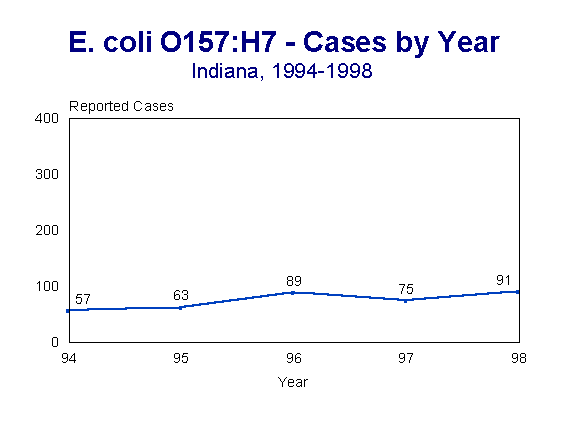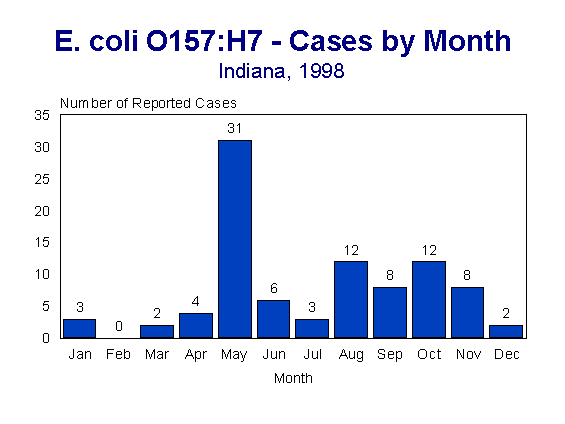
INFECTION WITH ESCHERICHIA COLI O157:H7
Cases = 91White = 1.3
Nonwhite = Unable to calculate
Gender-specific rates
(per 100,000 population)Female = 1.6
Male = 1.4
Escherichia coli O157:H7 infection is a bacterial disease usually transmitted through raw or undercooked foods of animal origin, or through foods cross contaminated by animal products. It has most commonly been associated with raw or undercooked hamburger. Outbreaks have also been attributed to unwashed produce, unpasteurized fruit juices, and swimming in or drinking untreated surface water. It can also be transmitted from person-to-person and is a special concern in the day care center setting.
There were 91 reported cases of E. coli O157:H7 in Indiana in 1998, which marks a 21% increase from the previous year (Figure 1). It is recommended that all clinical laboratories routinely screen all stool specimens for sorbitol-negative E. coli. Lack of sorbitol fermentation in E. coli is a biochemical marker for the O157:H7 type. The ISDH requests that clinical laboratories submit all sorbitol-negative E. coli isolates to the ISDH Disease Control Laboratory for free confirmation and subtyping services.
Figure 1.

An outbreak in May accounted for the increased numbers during that month, but incidence was generally greatest during the late summer and autumn months (Figure 2).
Figure 2.

There was little difference in rates of E. coli O157:H7 infection by sex. Age-specific rates were greatest among children aged one to four (3.7) which highlights the increased risk for transmission in day care centers (Figure 3). Transmission in day care centers can be avoided through exclusion of children with diarrhea and good everyday hand washing practices.
Figure 3.

Among counties with at least 5 cases reported, the incidence rate was highest in Johnson (15.9), Elkhart (3.8), and Marion (2.5) Counties (Figure 4).
Figure 4. E. coli 0157:H7 Incidence Rate by County
(among
counties with > 5 reported cases)
Indiana,
1998

The ISDH investigated one confirmed E. coli O157:H7 outbreak in 1998. In May, twenty-seven people became infected after consuming contaminated cole slaw at a Johnson County fast food restaurant. Unwashed cabbage was the likely source of contamination. This outbreak is described in more detail in Appendix D.
[an error occurred while processing this directive]